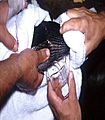Black sea bass facts for kids
Quick facts for kids Black sea bass |
|
|---|---|
 |
|
| Conservation status | |
| Scientific classification | |
| Synonyms | |
|
The black sea bass (Centropristis striata) is a type of fish that lives in the ocean. It's a member of the sea bass family, which also includes fish like groupers. You can find black sea bass in the western part of the Atlantic Ocean. This fish is very important for both people who fish for fun and those who fish to sell.
Contents
What Does a Black Sea Bass Look Like?
Black sea bass have a body that is a bit flat from side to side. They have a big mouth with many teeth. Their mouth opens wide, reaching below the middle of their eye.
They have two main fins on their back, called dorsal fins. The front part of these fins has 10 stiff spines. The fin on their underside, called the anal fin, has three spines. Their tail fin has three points, making it look a bit fancy.
The color of a black sea bass is usually smoky gray, dark brown, or blue-black on top. Their belly is lighter. Each scale has a small pale blue or white spot. These spots create stripes along their body. Their dorsal fin also has white spots and bands. Sometimes, their sides can look blotchy or have dark and light stripes.
When it's time to breed, male black sea bass become very colorful. They get bright blue and green around their eyes and neck. They also grow a small hump on their head. Females are usually duller, more brownish or blue-gray.
Young black sea bass, called juveniles, have different color patterns. Some are light gray with small dark spots. Others are dark with white spots, or have a single dark stripe. Some even have six vertical stripes.
These fish can grow up to about 66 centimeters (26 inches) long. However, they are usually around 30 centimeters (12 inches) long. The heaviest black sea bass ever recorded weighed about 4.1 kilograms (9 pounds).
Where Do Black Sea Bass Live?
Black sea bass live in the western Atlantic Ocean. You can find them from Nova Scotia in Canada, all the way south along the eastern coast of North America. Their range extends down to the Florida Keys and into the Gulf of Mexico, near Louisiana.
Life and Habits of the Black Sea Bass
Black sea bass love to hang out near rocks, jetties, and other structures in shallow water. They can also be found in deeper ocean waters, up to 130 meters (426 feet) deep. They often gather around things on the ocean floor, like rock piles, shipwrecks, or man-made structures.
You might see them resting with their head pointing up or down. They usually keep their dorsal fin folded down. But if they feel aggressive towards another black sea bass, they will raise and spread out this fin. Young black sea bass stay in protected areas like estuaries. They hide around structures and shell beds.
These fish grow slowly. They are ready to have babies when they are between one and three years old. Black sea bass are special because most of them start their lives as females. Later, some of the largest females can change into males. Scientists think this happens when there aren't enough males in a group.
Black sea bass lay their eggs from January to July. Smaller females lay about 30,000 eggs, while larger ones can lay up to 500,000 eggs! Their eggs float in the water and are very tiny. They hatch in about 75 hours if the water is around 16°C (61°F). The baby fish, called larvae, also float until they are about 13 millimeters (0.5 inches) long. Then they move closer to the bottom or into estuaries.
Black sea bass are hunters. They eat many different things, including crabs, shrimps, worms, and small fish. They also eat barnacles and clams.
Bigger fish also hunt black sea bass. Some of their known predators include monkfish, summer flounder, striped bass, and different types of sharks. Female black sea bass can live for about 8 years, while males can live up to 12 years.
How Black Sea Bass Got Their Name
The black sea bass was first officially described in 1758 by a scientist named Carl Linnaeus. He gave it the scientific name Labrus striatus. Later, another scientist created the group of fish called Centropristis. The black sea bass became the main example for this group.
The name Centropristis comes from two Greek words. Kentron means "a saw," and pristis means "sting."
Fishing for Black Sea Bass
Black sea bass are very popular with both people who fish for fun and commercial fishermen. Governments work together to manage how many black sea bass can be caught. This helps make sure there are enough fish for the future. They set limits on how many fish can be caught and when fishing is allowed.
The meat of black sea bass is white and lean. It has a firm texture and a delicate taste. Because most black sea bass are not very big, they are often cooked whole. Fishermen catch them using nets that drag along the bottom, hooks and lines, or special traps.
Scientists are also looking into raising black sea bass on fish farms. This could be another way to get these tasty fish in the future.
Images for kids
- McClane, A. J. (1978). McClane's Field Guide to Saltwater Fishes of North America. ISBN: 0-8050-0733-4
See also
 In Spanish: Centropristis striata para niños
In Spanish: Centropristis striata para niños




